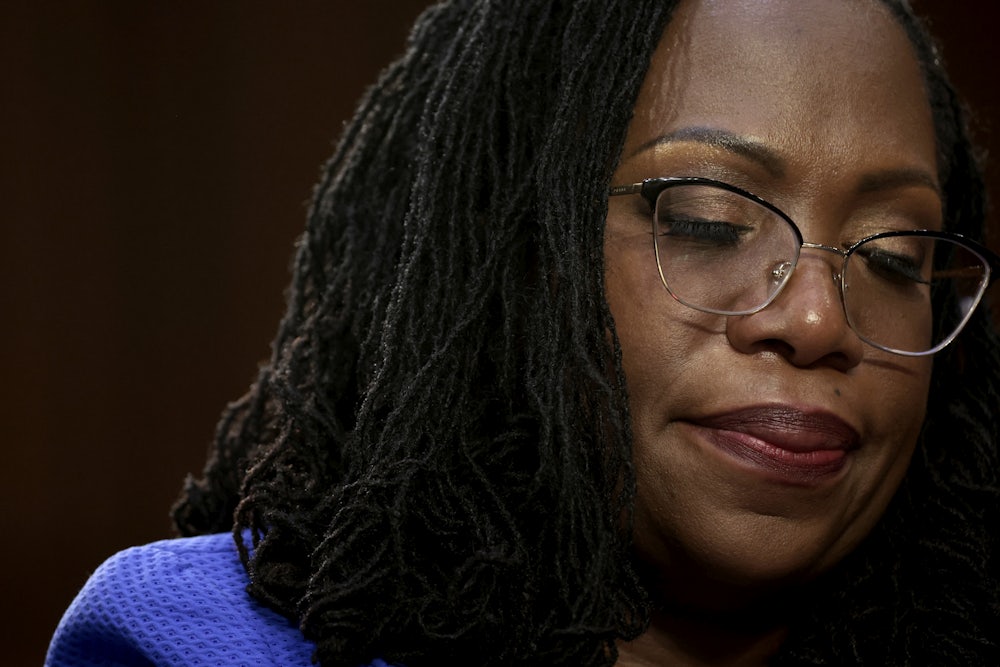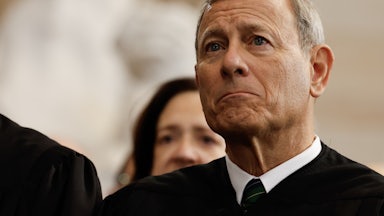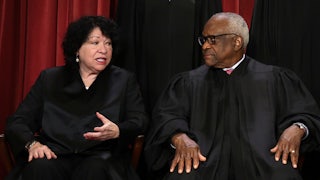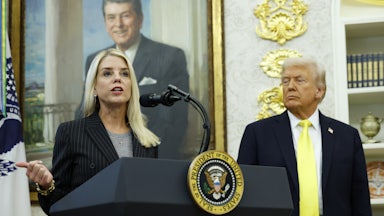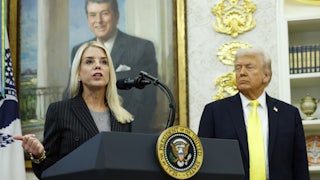Supreme Court justices typically play a more backbencher role in their first few terms on the court while they learn the institution’s rhythms and habits. Justice Ketanji Brown Jackson seems to be a quicker learner than most. In a dissenting opinion on Friday, she warned in unusually blunt terms that her colleagues’ apparent favoritism toward corporate interests was damaging the court’s public esteem.
The high court’s ruling in Diamond Alternative Energy v. EPA allowed a fuel-industry lawsuit targeting California’s vehicle emissions standards to go forward, overturning a lower court ruling that found the industry didn’t have standing to bring the lawsuit in the first place. Justice Brett Kavanaugh, writing for the court, held that the industry had given enough reasons to think the courts could remedy its claimed injuries, a key procedural hurdle in any litigation.
“The government generally may not target a business or industry through stringent and allegedly unlawful regulation, and then evade the resulting lawsuits by claiming that the targets of its regulation should be locked out of court as unaffected bystanders,” he wrote for a 7–2 majority that included all of the court’s conservative members and Justice Elena Kagan.
Jackson, in a solo dissent, noted that the case would almost certainly become moot in short order when the Trump administration revokes the rule in question. (The Environmental Protection Agency already began that process earlier this spring.) “I worry that the fuel industry’s gain comes at a reputational cost for this Court, which is already viewed by many as being overly sympathetic to corporate interests,” she wrote.
“Some knowledgeable researchers have suggested that this reputation is unfounded,” she wrote, citing other scholarly work that challenged those conclusions. “But, at this point, that unfortunate perception seems pervasive. And even the mere ‘appearance’ of favoritism, founded or not, can ‘undermine confidence in the integrity of the judiciary.’” Jackson paraphrased from a Supreme Court ruling on judicial ethics and, pointedly, quoted from a 2021 dissent by Justice Clarence Thomas on how claims of voter fraud weaken public confidence in the electoral process.
Jackson’s claims are not novel in and of themselves. She cited a range of sources, both scholarly and journalistic, that document the court’s deference toward business interests. The general trend of the court’s rulings in landmark cases also supports her case: The conservative justices have frequently formed majorities in cases to limit the federal government’s regulatory power, weaken protections for workers and labor unions, and strengthen wealthy Americans’ ability to influence politics in their favor.
For a Supreme Court justice to raise those concerns so bluntly in her official capacity is a potent sign of how dire the problem has become. And it is equally telling that the majority had no real rebuttal to her argument.
The case at hand springs from a challenge to California’s unique ability to set vehicle emissions standards. Congress enacted the Clean Air Act in 1971 to give the EPA the power to regularly set those standards nationwide. The law preempted state-level efforts to set their own standards, whether lower or higher, with the explicit exception of the Golden State, which can set its own higher standards in certain cases. From there, other states can choose to adopt the standards of either the EPA or California.
In theory, automakers could sell cars with different emission standards in different states when there’s a gap between the two regulatory regimes. But this would pose a series of logistical and engineering headaches for these companies, effectively forcing them to manufacture two versions of every model they sell in the United States. As a result, they typically defer to the higher one. That gives California an unusually preeminent role in setting nationwide environmental policy, at least where cars are concerned.
The auto industry does not have significant problems with this state of affairs. When Trump sought to revoke the California waiver and lower EPA standards during his first term, for example, the state struck a bargain with four major automakers to keep the higher ones. California also mounted a legal challenge to Trump’s efforts to revoke the waiver in court, which drew support from lower courts. The Biden administration restored the waiver when he took over in 2022, and Trump started trying to dismantle it again when he returned earlier this year.
Instead, the principal opponents of California’s standards system are the fuel industry—including both oil companies and ethanol manufacturers—and their Republican allies. Ohio and 16 other GOP-led states sued the EPA during the Biden administration to quash the California standard, openly bitter that the state played such a major role in shaping the national economy and arguing in favor of their own oil and gas producers. They lost in the lower courts, and the Supreme Court declined to hear the case last December.
Wednesday’s ruling comes from a parallel lawsuit by the fuel industry itself after Biden reinstated the California standards in 2022. Those standards would impose much more stringent requirements for carbon emissions on automakers and move them toward producing more zero-emissions vehicles. (California also tried to mandate a shift toward electric vehicles, but Trump and the Republican-led Congress blocked that effort earlier this month.) The fuel industry sought to overturn the revived waiver by arguing that it went beyond what Congress had envisioned in the 1970s when enacting the Clean Air Act.
The D.C. Circuit Court of Appeals rejected the industry’s claims, however, by arguing that it did not have standing to challenge the waiver. The industry argued that the waiver had injured it by allowing California to compel automakers to set higher fuel standards, which would reduce demand for its product. But the three-judge panel concluded that it had not provided any evidence that blocking the waiver would solve its problems. It would be too late to change any of the models already in production and preproduction, the court noted, and there is ample evidence that automakers are adopting higher standards anyway in response to market forces.
This is known in legal terms as redressability, and it is part of the calculus that courts use to determine whether litigants have standing to bring a lawsuit. Article 3 of the Constitution requires that U.S. courts only decide “cases and controversies,” and not merely render advisory opinions unmoored from any real-world consequences. It is not enough to be injured and to identify the party responsible for the alleged injury, in other words. A court must also be able to do something that can “redress” the injury’s harm for a lawsuit to go forward.
In response, the fuel industry asked the Supreme Court to intervene. “Article III standing should not be complicated here,” they wrote in their brief earlier this year. “The question is whether a party has standing to challenge a government action that works by depressing the market for that party’s products. To ask the question is to answer it.” The justices ultimately agreed to hear the case last fall, but only on the standing question and not on the merits of the waiver challenge itself.
The Trump administration, focusing only on the standing question, urged the justices to rule against the industry. Since the merits of the waiver itself aren’t before the court, the Trump Justice Department urged the justices to avoid adopting a more expansive view of Article 3 standing for legal challenges to federal agencies. It also noted that the case was likely to be moot soon anyway, since the administration planned to revoke the waiver once more.
“As previously explained, EPA is undertaking its own review of the 2022 reinstatement, and the agency may ultimately conclude in that process that California’s emissions standards have had a deleterious impact on American consumers and liquid fuel producers,” they told the justices in their brief. “But parties seeking to invoke the jurisdiction of the federal courts cannot rely on later administrative developments to establish that they satisfied Article III standing requirements at the time of suit.”
Kavanaugh, writing for the court, found those arguments unpersuasive. He concluded that the fuel industry need not prove that ruling against the waiver would fix all of its claimed injuries, but that it would likely help with at least some of them. “In short, the commonsense economic inferences about the operation of the automobile market—combined with the statements of the fuel producers, California, EPA, and the vehicle manufacturers—make it sufficiently ‘predictable’ that invalidating California’s regulations would likely redress the fuel producers’ injury,” he wrote.
Jackson, in dissent, saw no reason for the court to take up the case in the first place. “EPA is presently reviewing California’s pre-emption waiver, and as [the industry’s] counsel told us at oral argument, the agency is likely to withdraw that waiver imminently, which will put an end to California’s emissions program for good,” she wrote. “In fact, [their] counsel was so confident of that outcome that he told us he would bet his ‘bottom dollar’ on it. His confidence is not overstated.”
As a result, she noted, the court effectively went out of its way to unnecessarily decide something in the industry’s favor. “It may be difficult for the public to know exactly what to make of the Court’s decision to address the fleeting legal issue presented here,” she wrote. “For its part, the Court does not explain why it is so eager to resolve this highly fact-bound, soon-to-be-moot dispute.”
Jackson also took the unusual step of discussing the court’s internal process for selecting cases. The court typically does not explain why it does or does not take up certain cases, and there are few hard-and-fast rules governing the process. Legal journalists like myself are often left to hypothesize about the reasons based on past patterns. To that end, Jackson suggested that Friday’s ruling would give a troubling impression of the court’s priorities.
“For some, this silence will only harden their sense that the Court softens its certiorari standards when evaluating petitions from moneyed interests, looking past the jurisdictional defects or other vehicle problems that would typically doom petitions from other parties,” she wrote. “This Court’s simultaneous aversion to hearing cases involving the potential vindication of the rights of less powerful litigants—workers, criminal defendants, and the condemned, among others—will further fortify that impression.”
A careful reader might note that Jackson is not technically making these allegations herself but rather expressing concern about the impression that others have formed. This is a distinction without a difference. Jackson will likely serve on the court for the rest of her life, or close to it, and will probably spend decades working with some of her current colleagues. She has good reason to not call them out even more directly when this approach works just as well.
It is also striking that Kavanaugh conspicuously avoided any reference to her claims. He closed out his majority opinion with a brief section discussing the two dissents. Justice Sonia Sotomayor also wrote a brief one where she said it was unnecessary for the court to decide the case for fact-based reasons, which Kavanaugh briefly disputed. On Jackson’s claims, however, he was far more terse.
“Justice Jackson separately argues that the Court does not apply standing doctrine ‘evenhandedly,’” he wrote, quoting from her dissent. A review of standing cases over the last few years disproves that suggestion.” Then followed a lengthy list of citations to nine separate cases involving standing disputes that the court decided over the past five years. He did not explain further, except to repeat that “this court’s recent standing precedents support the conclusion that the fuel producers have standing.”
None of the other justices in the majority wrote separately to dispute Jackson’s concerns or otherwise rebut them. It is possible that they found it unnecessary to do so, or that they thought it would be a mistake to draw more attention to them. I can hardly blame them. It is hard to dispel concerns about something that is self-evidently true.
